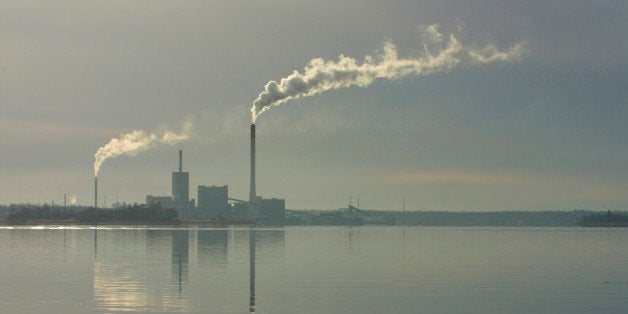
The main barrier to rebuilding America's decrepit infrastructure is not financing, but red tape. Delays of a decade or longer are common. Now, ironically, it turns out that years spent in environmental review dramatically harm the environment.
A new study by Common Good, which I led, found that delays in replacing obsolete infrastructure prolong massive amounts of pollution. America's antiquated power grid wastes six percent of total electricity -- the equivalent of 200 coal-burning power plants. Delays in permitting wind farms and other renewable power projects cause over 350 million tons of carbon to be released annually by plants using fossil fuels. (Review and permitting of the Cape Wind project in Massachusetts took nine years, and the litigation still continues.) Road bottlenecks cause traffic congestion, burning almost 2 billion extra gallons of gasoline each year. Leaky pipes, many installed a century ago, waste 2.1 trillion gallons of water. Waterways are polluted because inadequate sewage treatment plants overflow whenever there's a big storm. Desperately needed infrastructure projects languish for years. The Carlsbad desalination plant in water-parched California is opening this year, 12 years after it applied for permits.
Permitting delays also cause a cascade of other harmful effects. Six extra years of red tape more than doubles the overall cost of projects. Prolonging inefficient bottlenecks in roads, railroads, waterways and air traffic compromises American competitiveness. Worthwhile projects die or languish on the drawing board -- politicians lose interest because delays are longer than a normal political cycle.
Environmental review, when mandated by Congress in 1970, was supposed to foster better decisions. No one expected it to delay projects by more than a few months. Current regulations by the White House Council on Environmental Quality, created by Congress to oversee environmental review, state that environment impact statements should not be longer than 300 ages even in the most complex projects.
Environmental review has instead evolved into an agonizing crawl through years of meetings and mind-numbing detail. A project to raise the roadway of the Bayonne Bridge has almost no environmental impact -- it uses the same foundations and right of way -- but nonetheless required a 10,000 page environmental assessment. In another project, to expand a dock on the west coast, the initial "scoping meetings" took two years; only then could consultants even begin their review. The Savannah River dredging project consumed 14 years in environmental reviews. Such is the slow trudge through environmental review.
What happened is that, at the height of judicial activism in the 1970s, courts decided they would take a "hard look" at any environmental review statement. Environmental groups naturally accepted the invitation to challenge the detail of reviews. It gave them a legal bargaining chip.
The adequacy of environmental review -- not the wisdom the project -- became the battlefield for new projects. Reviews got longer and longer as stakeholders girded for litigation over whether the project proponents overturned every conceivable pebble. Former EPA General Counsel E. Donald Elliott estimates than 90% of the detail of environmental review is a response to potential claims in litigation.
The dynamic of delay is easy to understand. Every project has some harmful side effects. A desalination plant produces a briny byproduct. A wind farm mars nature views. A third rail tunnel under the Hudson will require huge digging and will dislocate people on the approach routes. Any group that doesn't like a project, or prefers it to be redesigned, can raise numerous issues, and threaten litigate if not satisfied. Years go by as participants tiptoe through a legal minefield. Meanwhile, bottlenecks and obsolete plants spew pollution into our air and water.
The Senate has passed a streamlining bill which would create a 16-agency Council to discuss and decide issues around permitting, including environmental review. Unfortunately it's not likely to speed things up much. A Committee of 16 is not a formula for action. What happens when one official (or his boss) feels really strongly that another agency is wrong? I asked one of the drafters who had authority to resolve disputes, and the answer was: Nobody.
The debate here is in the wrong dimension. The tension is not about cost vs. careful decisions, but progress vs. paralysis. Environmental review and public input are important, but only in a prescribed time frame. Other greener countries such as Germany have environmental review, but finish all review and permitting within one to two years -- not a decade or longer.
What's needed here is simple: Give an official (probably the Chair of the Council on Environmental Quality) authority to actually decide how much environmental review is needed. "Oh, the bridge is using the same foundations and right of way? Just provide a summary description of construction costs." Most reviews should be completed within months, not years or decades. That official answers to the President. Courts are available if someone ignores the law, but not for immaterial disputes.
Environmental review and permits should be completed in two years or less, not ten years. The quest for environmental perfection should be replaced by a practical assessment of what's really important. There's only one known way to cut through the bickering and red tape: Create clear lines of authority.
Modernizing America's infrastructure has an upside as rosy as the downside today is dire. America can enhance its competitiveness. Upwards of two million jobs can be created. And the environment will be far cleaner.